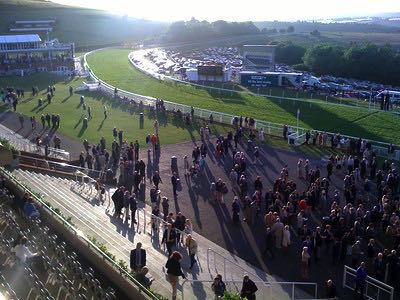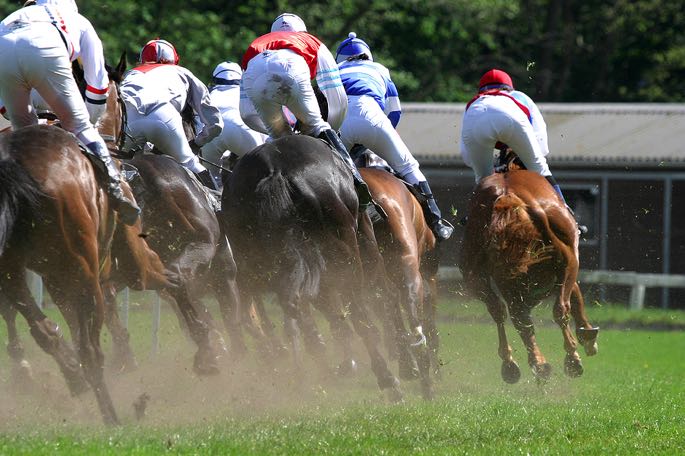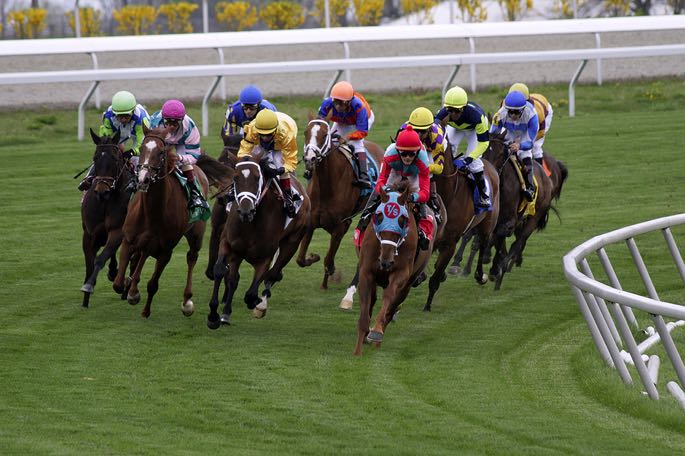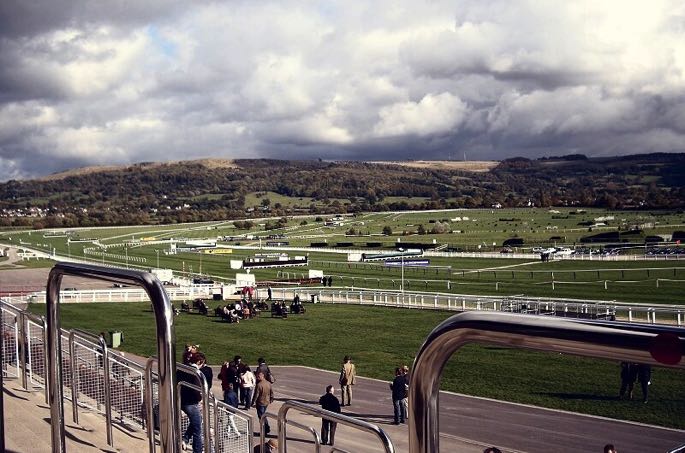
Goodwood is right handed (Dan Taylor-Watt / Flickr.com)
The term horses for courses is one of many phrases used in horse racing that has transcended the sport and become widely adopted in general parlance. Its origins come from the fact that some horses simply run better at certain courses than others. Racehorses are complex, highly tuned animals so it is little surprise that it matters to them whether the tracks they run on are hilly or flat, or if a course’s turns are tight or sweeping, or whether a racecourse is left or right handed.
Racing fans have long understood that some horses are much better at left handed racecourses and others at right handed tracks. Ascertaining how much of a difference the direction of a course makes requires an understanding of the physicality of racehorses and how laterality affects their racing. In this article, we look at this, as well as the split of left and right handed racecourses in Britain and beyond, below.
Horses’ Handedness/Laterality

Just like humans, the vast majority of racehorses have a dominant side. With the rare exception of ambidextrous horses who are equally strong on both sides, horses have a clear preference for either their right or left side. You can observe the dominant side of a horse (or laterality) in the way they naturally play or run, or when riding them if they have an easier time circling in one direction.
A horse’s laterality is observable both in the physical look of a horse and in their behaviour. In the same way that a right handed human has a slightly bigger right arm and leg, the forehooves of horses are noticeably bigger on their dominant side. This is because they favour that side and so it becomes naturally more developed over time. Horses will also develop slightly bigger and stronger muscles based on their laterality again similar to humans
Horses Have Clear Preference
Out on the race track, horses have a clear preference for running around bends that turn in the direction of their dominant side. They are both able to run stronger around courses that suit their dominant side and find it more challenging to go the wrong way. Moreover, there is a greater risk of injury when horses run at courses that do not suit their handedness.
Various studies have been undertaken on the laterality of horses. While the spread among the population is not as stark as in humans where only a little over 10% of people are left handed, there are more horses who favour their left than right. There is a difference between the sexes though with fillies and mares displaying more of a right handed laterality than colts and geldings.
The Impact on Racing

Amy N. Harris / Bigstockphoto.com
Horse racing trainers like to gather every bit of information they can about the horses in their care so that they can enter them in races they are more likely to win. While they will get an understanding of a horse’s dominant side early – often even before they have made their racecourse debut – they can’t truly know the impact it will have before the day of a race.
You will often hear trainers and jockeys talk about their horses running the wrong way round as an explanation for a poor performance. Punters are quick to pick up on this important information so it will have an impact on the betting markets. A horse who has a clear preference for running right handed may well be available at bigger odds than you would expect for a big race at Cheltenham for example.
The impact – both positive and negative – on the direction of a racecourse is applicable to both flat and jumps racing and on turf and all-weather surfaces. In all codes, it is travelling around a corner where the difference is most noticeable. Where there is a late bend that may translate in a horse either moving through the field strongly in the closing stages or seeing horses who were previously well positioned dramatically falling out of contention.
Flat Courses
It is worth noting here that many courses that host flat racing have straight courses, which can cater for shorter races sometimes up to one mile. While the bias for going a certain direction is not a factor on straight courses, it does have an impact on the draw. The first stall is always positioned closest to the inside of the turn with higher stalls moving towards the outside.
The first stall at Ascot, for example, is positioned to the inside of the course’s right hand turn whether a race takes place on the straight course or the round course. Ayr is another example. Races of six furlongs and under are held on the straight course, the start of which is at the opposite end of the course compared to the start for longer races. The first stall is to the inside of the left handed bend, rather than being arranged from north to south as you might expect.
Jumps Courses
Jumps racing provides an added challenge in general and therefore when it comes to the handedness of a horse. The reports of races will often mention a horse jumping out to either side. This is a result of one side being stronger than another and while trainers go to great lengths to coach this out of a horse when schooling them, it just can’t always be totally eradicated.
When the direction that a horse jumps out matches the direction of the racecourse, it may not be much of a concern. When it doesn’t match up it can be a serious impediment to the horse’s chances of winning. Additionally, it may be a safety concern with horses either making a mistake or careering into another runner.
Which Courses Are Left Handed & Which Are Right Handed?

Cheltenham is a left handed course (Sarah / Flickr.com)
We’ve already seen that there are slightly more horses with a left handed laterality than right handed. It makes sense, therefore, that there are more left handed racecourses in Britain than right handed. The tally is 38 left handed compared to 21 right handed with the full list below.
Left Handed Courses
- Aintree
- Ayr
- Bangor-on-Dee
- Bath
- Brighton
- Cartmel
- Catterick Bridge
- Chelmsford
- Cheltenham
- Chepstow
- Chester
- Doncaster
- Epsom Downs
- Fakenham
- Ffos Las
- Fontwell Park
- Great Yarmouth
- Haydock Park
- Hexham
- Kelso
- Lingfield
- Newbury
- Newcastle
- Newton Abbot
- Nottingham
- Plumpton
- Pontefract
- Redcar
- Sedgefield
- Southwell
- Stratford
- Thirsk
- Uttoxeter
- Warwick
- Wetherby
- Wolverhampton
- Worcester
- York
Right Handed Courses
- Ascot
- Beverley
- Carlisle
- Exeter
- Goodwood
- Hamilton
- Hereford
- Huntingdon
- Kempton Park
- Leicester
- Ludlow
- Market Rasen
- Musselburgh
- Newmarket
- Perth
- Ripon
- Salisbury
- Sandown
- Taunton
- Wincanton
- Windsor
Where horses have either a significant preference for running in one direction or find that their performances are hampered going left or right handed, their trainers will often enter them only on certain courses. That can be a serious problem simply because of where the biggest races take place.
Take the example of a high class staying chaser who has a clear preference for running on right handed racecourses. That may preclude them from being able to win a race at the Cheltenham Festival or the Grand National at Aintree as both courses are left handed. Instead, their trainer may have to target their star chaser at big races at right handed tracks such as the King George at Kempton.
Races with Both Left & Right Handed Courses
The ability to race well at different types of racecourse, including both left and right handed, is the mark of a truly top-class racehorse. That is one reason why the British Classics – the 1,000 and 2,000 Guineas, the Oaks and the Derby, and the St Leger – take in both left and right handed courses (Newmarket, Epsom and Doncaster). It’s the same for the Triple Crown of Hurdling – Newcastle, Kempton and Cheltenham – and for other big combinations of races such as the King George and the Gold Cup.
The very best racehorses are able to win at courses that are both left and right handed for a variety of reasons. It could be that they are a rare example of an ambidextrous horse (estimated by some farriers to be about one in every 1,000 horses). More likely it is because they are the beneficiary of excellent training at home or that their sheer ability allows them to overcome the disadvantage of running the wrong way.
Courses in Other Countries
Like Britain, Ireland has a combination of left and right handed racecourses. A mixture is also found in France and Australia but it is not universal. In America, for example, every racecourse goes right handed. There are a few suggestions as to why this is the case. One is that it is because horse racing began in the USA in 1788, just five years after the end of the American revolution, and that anti-British feeling was so high the decision was taken to do the opposite to the norm in Britain.
